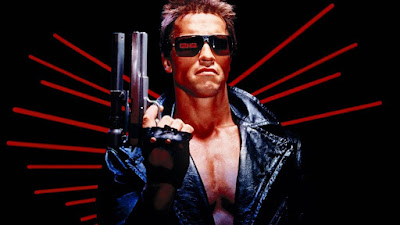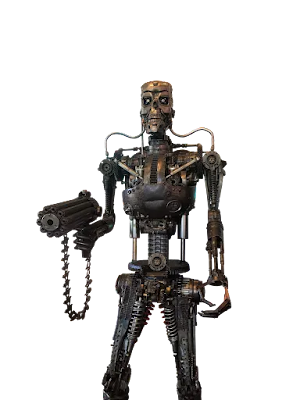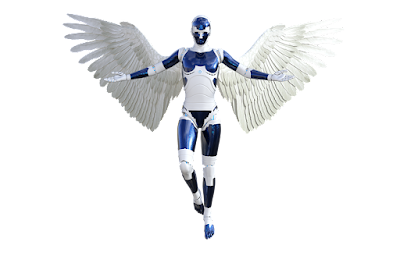In April 2000, Indiana University cognitive
scientist Douglas Hofstadter arranged a symposium called "Will Spiritual
Robots Replace Humanity by 2100?" at Stanford University.
Frank Drake, astronomer and SETI director, John Holland,
creator of genetic algorithms, Bill Joy of Sun Microsystems, computer scientist
John Koza, futurist Ray Kurzweil, public key cryptography architect Ralph
Merkle, and roboticist Hans Moravec were among the panelists.
Several of the panelists gave their thoughts on the
conference's theme based on their own writings.
- Kurzweil's optimistic futurist account of artificial
intelligence, The Age of Spiritual Machines, had just been published (1999).
- In Robot: Mere Machine to Transcendent Mind, Moravec
presented a positive picture of machine superintelligence (1999).
- Bill Joy had just written a story for Wired magazine called
"Why the Future Doesn't Need Us" on the triple technological danger
posed by robots, genetic engineering, and nanotechnology (2000).
- Only Hofstadter believed that Moore's Law doublings of
transistors on integrated circuits may lead to spiritual robots as a
consequence of the tremendous increase in artificial intelligence technologies.
Is it possible for robots to have souls?
Can they exercise
free will and separate themselves from humanity?
What does it mean to have a
soul for an artificial intelligence?
Questions like these have been asked since
the days of golems, Pinocchio, and the Tin Man, but they are becoming more
prevalent in modern writing on religion, artificial intelligence, and the
Technological Singularity.
Japan's robotics leadership started with puppetry.
Takemoto Giday and playwright Chikamatsu Monzaemon founded
the Takemoto-za in Osaka's Dotonbori district in 1684 to perform bunraku, a
theatrical extravaganza involving one-half life-size wooden puppets dressed in
elaborate costumes, each controlled by three black-clad onstage performers: a
principal puppeteer and two assistants.
Bunraku exemplifies Japan's long-standing fascination in
bringing inanimate items to life.
Japan is a world leader in robotics and artificial
intelligence today, thanks to a grueling postwar rebuilding effort known as
gijutsu rikkoku (nation building via technology).
Television was one of the first technologies to be widely
used under technonationalism.
The Japanese government hoped that print and electronic
media would encourage people to dream of an electronic lifestyle and reconnect
with the global economy by encouraging them to employ innovative technology to
do so.
As a result, Japan has become a major culture rival to the
United States.
Manga and anime, which feature intelligent and humanlike
robots, mecha, and cyborgs, are two of Japan's most recognizable entertainment
exports.
The notion of spiritual machinery is widely accepted in
Japan's Buddhist and Shinto worldviews.
Masahiro Mori, a roboticist at Tokyo Institute of
Technology, has proposed that a sufficiently powerful artificial intelligence
may one day become a Buddha.
Mindar, a robot based on the Goddess of Mercy Kannon
Bodhisattva, is a new priest at Kyoto's Kodaiji temple.
Mindar is capable of presenting a sermon on the popular
Heart Sutra ("form is empty, emptiness is form") while moving arms,
head, and torso, and costs a million dollars.
Robot partners are accepted because they are among the
things thought to be endowed with kami, the spirit or divinity shared by the
gods, nature, objects, and people in the Shinto faith.
In Japan, Shinto priests are still periodically summoned to
consecrate or bless new and abandoned electronic equipment.
The Kanda-Myokin Shrine, which overlooks Tokyo's Akihabara
electronics retail area, provides prayer, rituals, and talismans aimed at
purifying or conferring heavenly protection on items like smart phones,
computer operating systems, and hard drives.
Americans, on the other hand, are just now starting to
grapple with issues of robot identity and spirituality.
This is partly due to the fact that America's leading faiths
have their roots in Christian rites and practices, which have traditionally
been adverse to science and technology.
However, the histories of Christianity and robotics are
intertwined.
In the 1560s, Philip II of Spain, for example, commissioned
the first mechanical monk.
Mechanical automata, according to Stanford University
historian Jessica Riskin (2010), are uniquely Catholic in origin.
They allowed for computerized reenactments of biblical tales
in churches and cathedrals, as well as artificial equivalents of real humans
and celestial entities like as angels for study and contemplation.
They also aided Renaissance and early modern Christian
thinkers and theologians in contemplating conceptions of motion, life, and the
incorporeal soul.
By the middle of the eighteenth century, "There was no
dichotomy between machinery and divinity or vitality in the culture of living
machinery that surrounded these machines," Riskin writes.
"On the contrary, the automata symbolized spirit in all
of its bodily manifestations, as well as life at its most vibrant" (Riskin
2010, 43).
That spirit is still alive and well today.
SanTO, described as a robot with "divine
qualities" and "the first Catholic robot," was unveiled at a
conference of the Institute of Electrical and Electronics Engineers in New
Delhi in 2019. (Trovato et al. 2019).
In reformist churches, robots are also present.
To commemorate the 500th anniversary of the Reformation, the
Protestant churches of Hesse and Nassau unveiled the interactive, multilingual
BlessU-2 robot in 2017.
The robot, as its name indicates, selects specific blessings
for particular attendees.
The Massachusetts Institute of Technology's God and
Computers Project intended to establish a conversation between academics
developing artificial intelligence and religious experts.
She characterized herself as a "theological
counselor" to MIT's Humanoid Robotics Group's emotional AI experimental
robots Cog and Kismet.
Foerst concluded that embodied AI becomes engaged in the
divine image of God, develops human capabilities and emotional sociability, and
shares equal dignity as a creature in the universe via exercises in machine-man
connection, intersubjectivity, and ambiguity.
"Victor Frankenstein and his creation may now be
pals."
Frankenstein will be able to accept that his creation, which he saw
as a machine and an objective entity, had evolved into a human person"
(Foerst 1996, 692).
Deep existential concerns about Christian thinking and
conduct are being raised by robots and artificial intelligence.
Since the 1980s, according to theologian Michael DeLashmutt
of the Episcopal Church's General Theological Seminary, "proliferating
digital technologies have given birth to a cultural mythology that presents a
rival theological paradigm to the one presented by kerygmatic Christian
theology" (DeLashmutt 2006, i).
DeLashmutt opposes techno-theology for two reasons.
First, technology is not inherently immutable, and as such,
it should not be reified or given autonomy, but rather examined.
Second, information technology isn't the most reliable tool
for comprehending the world and ourselves.
In the United States, smart robots are often considered as
harbingers of economic disruption, AI domination, and even doomsday.
Several times, Pope Francis has brought up the subject of
artificial intelligence ethics.
He discussed the matter with Microsoft President Brad Smith
in 2019.
The Vatican and Microsoft have teamed together to award a
prize for the finest PhD dissertation on AI for social benefit.
In 2014, creationist academics at Matthews, North Carolina's
Southern Evangelical Seminary & Bible College bought an Aldebaran Nao
humanoid robot to much fanfare.
The seminarians wanted to learn about self-driving cars and
think about the ethics of new intelligent technology in the perspective of
Christian theology.
The Ethics and Religious Liberty Commission of the Southern
Baptist Convention produced the study "Artificial Intelligence: An
Evangelical Statement of Principles" in 2019, rejecting any AI's intrinsic
"identity, value, dignity, or moral agency" (Southern Baptist
Convention 2019).
Jim Daly of Focus on the Family, Mark Galli of Christianity
Today, and theologians Wayne Grudem and Richard Mouw were among the
signatories.
Some evangelicals argue that transhumanist ideas regarding
humanity's perfectibility via technology are incompatible with faith in Jesus
Christ's perfection.
The Christian Transhumanist Association and the Mormon
Transhumanist Association both oppose this viewpoint.
Both organizations acknowledge that science, technology, and
Christian fellowship all contribute to affirming and exalting humanity as
beings created in the image of God.
Robert Geraci, a religious studies professor at Manhattan
College, wonders if people "could really think that robots are aware if
none of them exercise any religion" (Geraci 2007).
He observes that in the United States, Christian sentiment
favors virtual, immaterial artificial intelligence software over materialist
robot bodies.
He compares Christian faith in the immortality of the soul
to transhumanists' desire for entire brain emulation or mind uploading into a
computer.
Mind, according to neuroscientists, is an emergent
characteristic of the human brain's 86 billion neurons' networking.
Christian longing for transcendence have similarities to
this intellectual construct.
Artificial intelligence's eschatology also contains a
concept of freedom from death or agony; in this instance, the afterlife is
cyberspatial.
New faiths, at least in part inspired by artificial
intelligence, are gaining popularity.
The Church of Perpetual Life, based in Hollywood, Florida,
is a transhumanist worship institution dedicated to the advancement of
life-extension technology.
Cryonics pioneers Saul Kent and Bill Faloon launched the
church in 2013.
Artificial intelligence serial entrepreneur Peter Voss and
Transhumanist Party presidential candidate Zoltan Istvan are among the
professionals in artificial intelligence and transhumanism who have visited the
center.
Martine and Gabriel Rothblatt formed the Terasem Movement, a
religion related with cryonics and transhumanism.
"Life is intentional, death is voluntary, god is
technical, and love is fundamental," the faith's basic doctrines state
(Truths of Terasem 2012).
The realistic Bina48 robot, created by Hanson Robotics and
modeled after Martine's husband, is in part a demonstration of Terasem's
mindfile-based algorithm, which Terasem believes could one day allow legitimate
mind uploading into an artificial substrate (and maybe even bring about
everlasting life).
Heaven, according to Gabriel Rothblatt, is similar to a
virtual reality simulation.
Anthony Levandowski, an engineer who oversaw the teams that
produced Google and Uber's self-driving vehicles, launched The Way of the
Future, an AI-based religion.
Levandowski is driven by a desire to build a
superintelligent, artificial god with Christian morals.
"If anything becomes much, much smarter in the
future," he continues, "there will be a changeover as to who is truly
in command."
"What we want is for the planet's control to pass
peacefully and peacefully from people to whoever."
And to make sure that
'whatever' understands who assisted it in getting along" (Harris 2017).
He is driven to ensure that artificial intelligences have
legal rights and are fully integrated into human society.
Spiritual robots have become a popular science fiction
motif.
Cutie (QT-1) convinces other robots that human people are
too mediocre to be their creators in Isaac Asimov's short tale
"Reason" (1941).
Instead, Cutie (QT-1) encourages them to worship the power
plant on their space station, calling it the Master of both machines and
mankind.
The Mission for Saint Aquin (1951), by Anthony Boucher, is a
postapocalyptic novelette that pays tribute to Asimov's "Reason."
It
follows a priest called Thomas on a postapocalyptic quest to find the famous
evangelist Saint Aquin's last resting place (Boucher patterns Saint Aquin after
St. Thomas Aquinas, who used Aristotelian logic to prove the
existence of God).
Saint Aquin's corpse is said to have never decayed.
The priest rides a robass (robot donkey) with artificial
intelligence; the robass is an atheist and tempter who can engage in
theological debate with the priest.
When Saint Aquin is finally discovered after many trials, he
is revealed to be an incorruptible android theologian.
Thomas is certain of the accomplishment of his quest—he has
discovered a robot with a logical brain that, although manufactured by a human,
believes in God.
In Stanislaw Lem’s novella “Trurl and the Construction of
Happy Worlds” (1965), a box-dwelling robot race created by a robot engineer is
persuaded that their habitat is a paradise to which all other creatures should
aspire.
The robots form a religion and begin making preparations to
drill a hole in the box in order to bring everyone outside the box into their
paradise, willingly or unwillingly.
The constructor of the robots is enraged by this idea, and
he destroys them.
Clifford D. Simak, a science fiction grandmaster, is also known for his
spiritual robots.
Hezekiel is a robot abbot who leads a Christian congregation
of other robots in a monastery in A Choice of Gods (1972).
The group has received a communication from The Principle, a
god-like creature, although Hezekiel believes that "God must always be a
pleasant old (human) gentleman with a long, white, flowing beard" (Simak
1972, 158).
The robot monks in Project Pope (1981) are on the lookout
for paradise and the meaning of the cosmos.
John, a mechanical gardener, tells the Pope that he believes
he has a soul.
The Pope, on the other hand, is not so sure.
Because humans refuse to let robots to their churches, the
robots establish their own Vatican-17 on a faraway planet.
A massive computer serves as the Pope of the Robots.
Androids idolize their creator Simeon Krug in Robert
Silverberg's Hugo-nominated novel Tower of Glass (1970), hoping that he would
one day free them from harsh slavery.
They leave faith and rebel when they learn Krug is
uninterested in their freedom.
Silverberg's Nebula award-winning short story "Good
News from the Vatican" (1971) is about an artificially intelligent robot
who is elected Pope Sixtus the Seventh as a compromise candidate.
"If he's elected," Rabbi Mueller continues,
"he wants an instant time-sharing arrangement with the Dalai Lama, as well
as a reciprocal plug-in with the chief programmer of the Greek Orthodox church,
just to start" (Silverberg 1976, 269).
Television shows often include spiritual robots.
In the British science fiction comedy Red Dwarf (1988–1999),
sentient computers are equipped with belief chips, which convince them of the
existence of silicon paradise.
At the animated television series Futurama (1999–2003,
2008–2013), robots worship in the Temple of Robotology, where Reverend Lionel
Preacherbot delivers sermons.
The artificial Cylons are monotheists in the popular reboot
and reinterpretation of the Battlestar Galactica television series (2003–2009),
whereas the humans of the Twelve Colonies are polytheists.
~ Jai Krishna Ponnappan
Find Jai on Twitter | LinkedIn | Instagram
You may also want to read more about Artificial Intelligence here.
See also:
Foerst, Anne; Nonhuman Rights and Personhood; Robot Ethics; Technological Singularity.
References & Further Reading:
DeLashmutt, Michael W. 2006. “Sketches Towards a Theology of Technology: Theological Confession in a Technological Age.” Ph.D. diss., University of Glasgow.
Foerst, Anne. 1996. “Artificial Intelligence: Walking the Boundary.” Zygon 31, no. 4: 681–93.
Geraci, Robert M. 2007. “Religion for the Robots.” Sightings, June 14, 2007. https://web.archive.org/web/20100610170048/http://divinity.uchicago.edu/martycenter/publications/sightings/archive_2007/0614.shtml.
Harris, Mark. 2017. “Inside the First Church of Artificial Intelligence.” Wired, November 15, 2017. https://www.wired.com/story/anthony-levandowski-artificial-intelligence-religion/.
Riskin, Jessica. 2010. “Machines in the Garden.” Arcade: A Digital Salon 1, no. 2 (April 30): 16–43.
Silverberg, Robert. 1970. Tower of Glass. New York: Charles Scribner’s Sons.
Simak, Clifford D. 1972. A Choice of Gods. New York: Ballantine.
Southern Baptist Convention. Ethics and Religious Liberty Commission. 2019. “Artificial Intelligence: An Evangelical Statement of Principles.” https://erlc.com/resource-library/statements/artificial-intelligence-an-evangelical-statement-of-principles/
Trovato, Gabriele, Franco Pariasca, Renzo Ramirez, Javier Cerna, Vadim Reutskiy, Laureano Rodriguez, and Francisco Cuellar. 2019. “Communicating with SanTO: The First Catholic Robot.” In 28th IEEE International Conference on Robot and Human Interactive Communication, 1–6. New Delhi, India, October 14–18.
Truths of Terasem. 2012. https://terasemfaith.net/beliefs/.

















